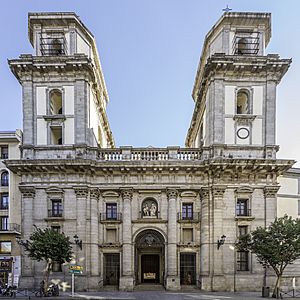San Isidro, Madrid facts for kids
Quick facts for kids St. Isidore's Collegiate Church |
|
|---|---|
| Colegiata de San Isidro el Real | |
|
Real Basílica Colegiata de San Isidro
|
|

Façade and twin belfries
|
|
| Location | Madrid |
| Country | Spain |
| Denomination | Catholic Church |
| History | |
| Status | Minor basilica |
| Dedication | Isidore the Laborer |
| Consecrated | 23 September 1651 |
| Architecture | |
| Style | Spanish Baroque |
| Administration | |
| Archdiocese | Madrid |
St. Isidore's Collegiate Church, also known as the Colegiata, is a beautiful old Catholic church in the heart of Madrid, Spain. It was built in the Baroque style, which means it has lots of fancy decorations. The church is named after Saint Isidore, who is the special patron saint of Madrid. It also holds some of his relics, which are important historical items. His wife, Santa María de la Cabeza, is also honored here. For a very long time, this church has been known as a minor basilica, which is a special title given by the Pope.
Contents
History of the Church
Building a New Church
The church you see today replaced an older church from the 1500s. That old church was called Saints Peter and Paul. It was taken down to make space for a new school, the Imperial College. This happened because Maria of Austria, who was an empress, wanted it. She left her money to the Society of Jesus, a group of priests, so they could build a new church and school.
Design and Construction
The design for the church started in 1620. An architect named Pedro Sánchez began the work two years later. After he passed away in 1633, Francisco Bautista and Melchor de Bueras took over. They finished building the church in 1664. Even though it was finished in 1664, the church was officially blessed and opened on September 23, 1651.
Changes Over Time
This church was first connected to the Jesuits. It was dedicated to Saint Francis Xavier, an important Jesuit missionary. But in 1767, the Jesuits were asked to leave Spain. After that, the church became a "collegiate church."
Two years later, in 1769, the church was rededicated to Saint Isidore. This happened when his relics were moved from another church, the Church of Saint Andrew. Saint Isidore's remains had been kept there since the 1500s. His wife's relics, Saint Mary of the Head, were also moved. A famous architect named Ventura Rodríguez redesigned the inside of the church. He created a beautiful new main altar and the area around it.
A Cathedral for a While
In 1885, when Madrid got its own Catholic archdiocese, St. Isidore's Church became a "pro-cathedral." This meant it served as the main church until a new, bigger cathedral could be built. It kept this important role until 1993. That's when the current main cathedral, the Almudena Cathedral, was finished. After that, St. Isidore's went back to being a collegiate church.
Fire and Restoration
In 1936, during the Spanish Civil War, the church caught fire. The dome, which is the big rounded roof, fell down. Many beautiful artworks were destroyed, including the fancy main altar designed by Rodríguez. Paintings by Luca Giordano Ricci were also lost.
After the war ended, people worked very hard for over twenty years to fix the church. They tried to make it look just like it did before the fire. They even made a new main altar that was exactly like Rodríguez's original design. The restoration finished in the 1960s. A new part was added to the church's towers by architect Javier Barroso.
The chapel dedicated to Our Lady of Mount Carmel was also restored. This chapel is sometimes called "Our Lady of the Sailors Chapel." The money for its restoration came from the British Embassy in Madrid. You can even see the Coat-of-Arms of the United Kingdom above the altar there.
See also
 In Spanish: Colegiata de San Isidro para niños
In Spanish: Colegiata de San Isidro para niños
- Catholic Church in Spain
- List of Jesuit sites
- List of oldest church buildings

